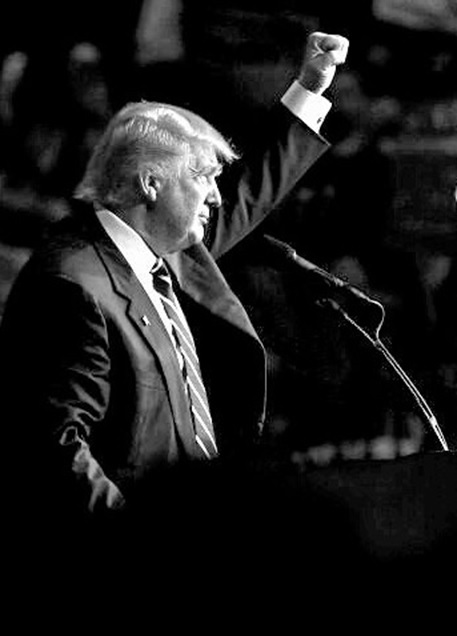

CTH
Don't focus solely on the headline-grabbing national polls. Although they are useful in terms of high-level sentiment and trends, that's not how presidential elections are decided.Election season is well underway. President Joe Biden is mumbling, bumbling, and stumbling his way toward his party’s nomination for a second term, the final nail in the coffin of American greatness and exceptionalism.
Former President Trump is supposedly so unlikeable that his opponents are trying to arrest and imprison him in the style of a banana republic dictatorship, which America is rapidly becoming.
Opinion polls are a snapshot of public sentiment and preferences. In the case of presidential election polls, polls reflect the views of a hopefully representative sample of the U.S. voting population which when extrapolated, mirror the views of the entire country.
But are national polls truly relevant? The president is not selected based on a national popular vote, despite efforts from the left to decide elections in this manner.
Otherwise, a handful of large Democrat-controlled cities could control the election outcome through votes and voter fraud. What about the rest of the country?
The Founding Fathers, in one of their many acts of genius, devised the Electoral College. Each state is allocated some of the 538 electors, corresponding to the state’s number of congressional (House and Senate) representatives.
The winner of the popular vote of each state is typically assigned all the electors in a winner-takes-all manner. In other words, the presidential election is a series of 50 state elections, not one big national election.
As such, even small states have enough electoral college votes to be relevant whereas in a national popular vote, smaller states would be drowned out by large metropolitan population centers.
Most states are reliably Democrat or Republican, blue or red, and their electoral college votes are a foregone conclusion. But a handful of battleground states may tilt one way or the other, depending on the year. It’s these swing states where the election is often decided, a battle between the two parties, hence the battleground designation.
In 2000, George W. Bush lost the popular vote to Al Gore by a half of a percent. In 2016, Donald Trump lost by 2 percent to Hillary Clinton. The Electoral College “trumped” the popular vote in these outlier elections.
National polls are certainly favorable for Trump and his supporters. Rasmussen Reports late May survey results are an example, with this headline regarding likely U.S. voters, “Trump +5 Over Biden.”
CNN confirms this. In their recent poll among registered voters, Trump’s support sits at 49% compared to Biden at 43%.
The Real Clear Politics average shows Trump a point ahead of Biden. This is post-conviction from Judge Merchan’s kangaroo court.
A post-trial Morning Consult poll gives Trump a one-point lead over Biden. A NYT/Sienna poll found that Trump’s New York conviction made no difference in the presidential race.
While good news for Republicans, at least those who prefer to win rather than pouting over Trump’s name calling and brash personality, the election comes down to a half dozen or so battleground states. What do those state level polls say?
Let’s ask Real Clear Politics, that tracks and averages these polls.
It’s these seven states that will likely determine who will be in the Oval Office a year from now. These seven states represent 93 electoral college votes, a third of the necessary 270 votes for victory.
These are the states where Trump will be holding his rallies. This is where the campaign money and ads will be laser focused.
Liberty Daily confirms these battleground state polls, as do the voters,
Trump is beating President Joe Biden by 13% among likely Nevada voters, 9% in Georgia, 6% in Arizona, 3% in Pennsylvania and 1% in Wisconsin, according to New York Times/SienaCollege polling published in May.
Wisconsin voters told CNN chief national affairs correspondent Jeff Zeleny in a segment aired Wednesday that the conviction of former President Donald Trump will not influence who they cast ballots for in the presidential election.
The point is to not focus solely on the headline-grabbing national polls. Although they are useful in terms of high-level sentiment and trends, that’s not how presidential elections are decided.
<img alt captext="CTH” class=”post-image-right” src=”https://conservativenewsbriefing.com/wp-content/uploads/2024/06/dont-overrely-on-national-presidential-polls.jpg” width=”400″>Democrats are unhappy with this fact, especially after Al Gore and Hillary Clinton lost their presidential bids via the Electoral College despite winning the national popular vote.
When the left doesn’t like the outcome of the game, they endeavor to change the rules. Hence the National Popular Vote bill,
The presidential candidate receiving the most popular votes in all 50 states and DC will get all the electoral votes from all the enacting states. That is, the candidate receiving the most popular votes nationwide will be guaranteed enough electoral votes to become President.
A constitutional amendment abolishing the Electoral College is not even necessary. According to Article 2, Section 1 of the U.S. Constitution,
Each state shall appoint, in such manner as the legislature thereof may direct, a number of electors, equal to the whole number of Senators and Representatives to which the state may be entitled in the Congress.
States could simply appoint electors who agree to vote for the candidate who wins the national popular vote. Sixteen states have enacted such legislation, fortunately all blue states that will more than likely be giving their electoral votes to the Democrat candidate under both current procedures or the new proposed scheme.
Red states would be foolish to sign onto this scheme as rigged elections in a handful of Democrat stronghold cities would guarantee the Democrat winning the popular vote.
Trump leading in the important battleground states is the political landscape today. But much can and will change over the next five months before the election. President Biden and his policies are becoming increasing unpopular. Stagflation, an open border, and the world inching ever closer to nuclear war are not issues Biden wants to run on.
Rasmussen Reports in their May 29 Presidential Tracking Poll found that only 44% of likely U.S. voters approve of Biden’s job performance whereas 55% disapprove.
32% of likely U.S. voters believe the country is heading in the right direction compared to 64% who feel we are headed down the wrong track.
Lastly from Rasmussen Reports, “Nearly half of voters — including a majority of Democrats — think it’s okay for the Democratic Party to replace President Joe Biden with some other candidate.”
Biden’s cognitive decline is becoming obvious, even to the Trumpophobic Wall Street Journal, which recently noted, “Participants in private meetings with 81-year-old President Biden say he has shown signs of slipping.” Ya think?
Will the Democrat ruling class make Joe an offer he can’t refuse? Or invoke the 25th Amendment?
A change of batter would shake up the above poll numbers, whether the new player is Kamala Harris, Michelle Obama, Gavin Newsom, Jay Pritzker, or some other Democrat governor.
Biden’s fading fortunes are causing Democrat dyspepsia. In fact, “Dems in full-blown ‘freakout’ over Biden” according to Politico.
Regardless of candidate popularity, voting shenanigans may negate the preferences of American voters. A recent study found that “25% of non-citizens are illegally registered to vote.”
With 17 million illegal immigrants living in America, this 25% translates to over 4 million votes, or 2.5 % of the 155 million votes cast. Four million votes in battleground states would alter the election, considering many states had a winning margin in the tens of thousands of votes.
While the national polls provide a shot of adrenalin if one’s preferred candidate is leading, this is not how the next president will be chosen. Keep an eye on those battleground state poll numbers for the real state of the electorate.
Brian C Joondeph, MD, is a physician and writer.
Follow me on Twitter @retinaldoctor
Substack Dr. Brian’s Substack
Truth Social @BrianJoondeph
LinkedIn @Brian Joondeph
Image: ConservativeTreeHouse






